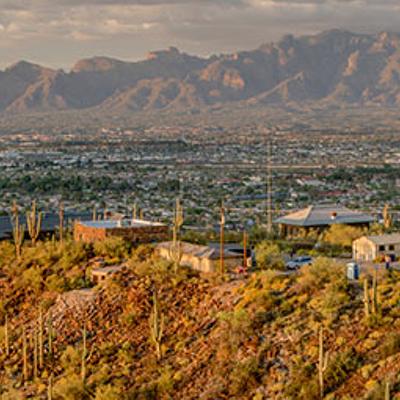It's 10 a.m. and sunny, with a touch of brisk morning air. After 30 minutes, I've hiked through a forest of saguaros, palo verde trees and shrubs, sharing it with Arizona wildlife.
With the valley stretching around me, I have an exquisite view from Tumamoc Hill, aka "Tucson's best-kept secret."
Tumamoc, which is home to UA ecological-research facilities, as well as the ruins of a 2,300-year-old village, is a National Historic Landmark and draws about 7,000 hikers every week, according to Michael Rosenzweig, director of UA facilities on the hill.
"When I turn up the road to go into the hill, it's like going into a time machine," Rosenzweig said. "It's magic. Just magic."
Last weekend, activities for Celebrate Tumamoc, a free event in honor of Arizona's centennial, included a hike. The festivities continue from 10 a.m. to 5 p.m., Saturday and Sunday, Jan. 28 and 29, and will offer an enriching learning experience about UA's Desert Laboratory and its ecological work and conservation efforts, Rosenzweig said. Activities include a scenic walk, tours of historic buildings, live music and opportunities to view artists at work and ask scientists questions.
Of course, the hill is also popular with hikers. Dr. Ron Spark, the coordinator for the Tumamoc Walkers group, said he has seen people with health-related problems who still continue to walk the hill. These include people who have had missing limbs, had cancer or have been on oxygen, "and yet they still come, and they find something of great value," he said.
This weekend's activities are "an opportunity to get acquainted with people that use the hill, love the hill and really treasure it," Spark said.
The open-house-style event will be a well-rounded cultural experience, Rosenzweig said—and even people who think they know the hill will be surprised by some of what they see.
The boathouse—a spot where boats were once made, which has been closed since the early 1980s—is now being opened to the public. Previously, it was used as a base for scientific field operations, and equipment was stored there to keep it out of the elements, Rosenzweig said.
In another building, local artist Paul Mirocha has a studio where he runs a sketching club. Members will have works on display and will be available to discuss them. Mirocha plans to talk about "drawing as seeing," and how people don't need to be accomplished artists in order to gain insight from drawing, Rosenzweig said.
From noon to 5 p.m. on Saturday and Sunday, musicians will play in a variety of styles, including African and Brazilian music, and classical guitar.
In addition to the centennial festivities, there's also the likelihood of spotting wild animals.
"If you pay attention and keep looking at the hill, you sometimes are rewarded," Spark said. In the six years Spark has been involved with Tumamoc Hill, he has seen javelinas, herds of deer, foxes and bobcats. Last Sunday, Kristin Albert, a wildlife biologist with the UA, held a common kingsnake in her hands as she talked about different species present on the hill. Albert said Tumamoc is tracking seven different kinds of snakes.
"People still don't know that there's so much work being done up here," she said.
Though Tumamoc is without doubt a beautiful slice of desert, there was a time when horses, cattle and goats "chomped the place to hell," Rosenzweig said. Tumamoc's pristine desert appearance was achieved after 30 years of restoration through conservation and ecological work, he said.
"This whole landscape is a creation of the scientific institution itself. That is something almost nobody remembers," he said. "This is an international treasure which (many Tucsonans) don't know anything about."
Because of UA's conservation work, communities around the world can see what needs to be done in order to preserve species and environments, Rosenzweig said. "We're tackling a couple of jobs in one ... saving biodiversity on the planet and also increasing biodiversity all over the city."
As for the hill's long-time occupation by humans, Rosenzweig said, "We're not Babylon or Athens, but we have a legacy of archaeological ruins that goes back something like 2,300 years ... and it's extremely important for understanding the Native American cultures that existed then and in the intervening centuries."









